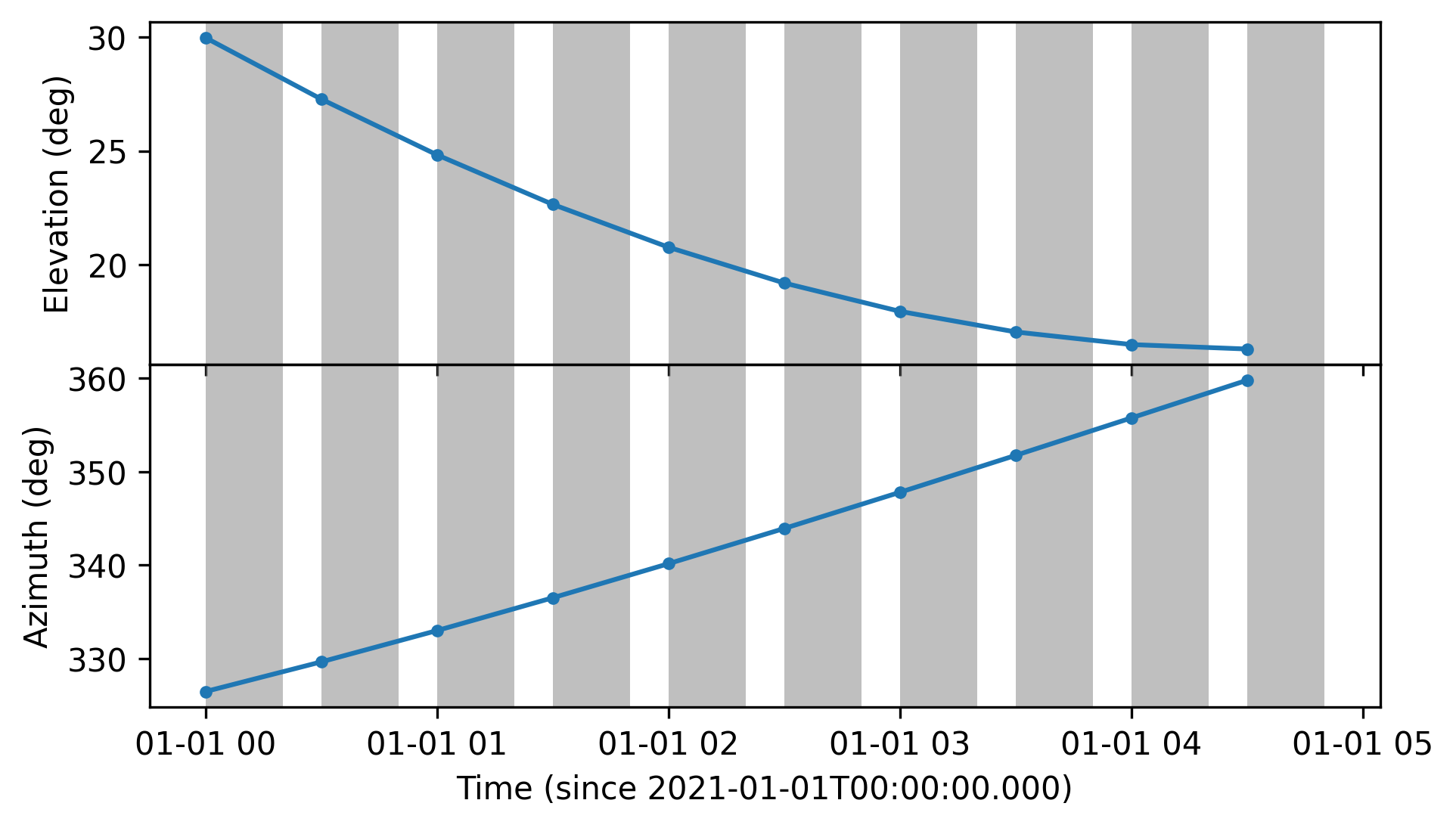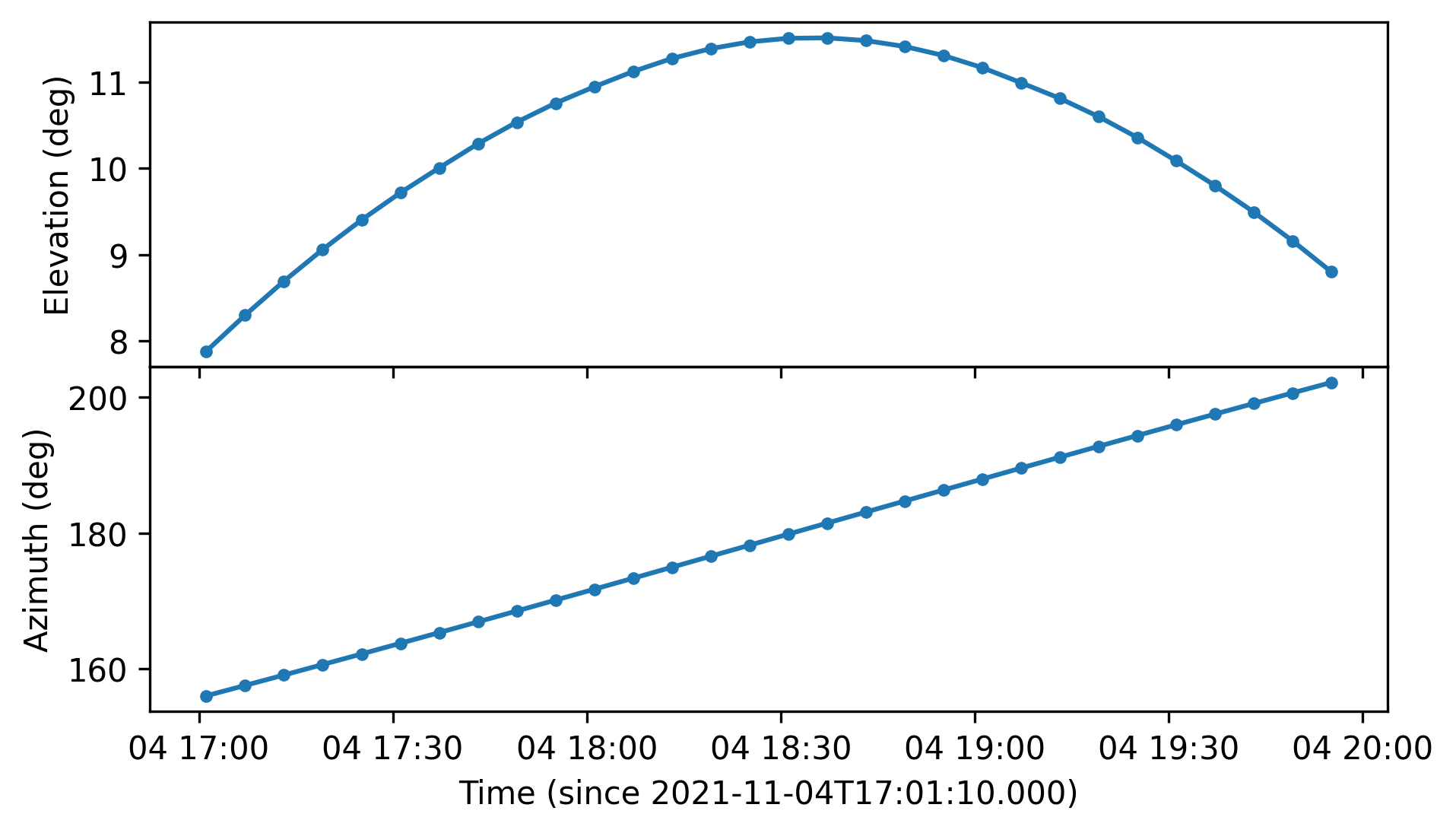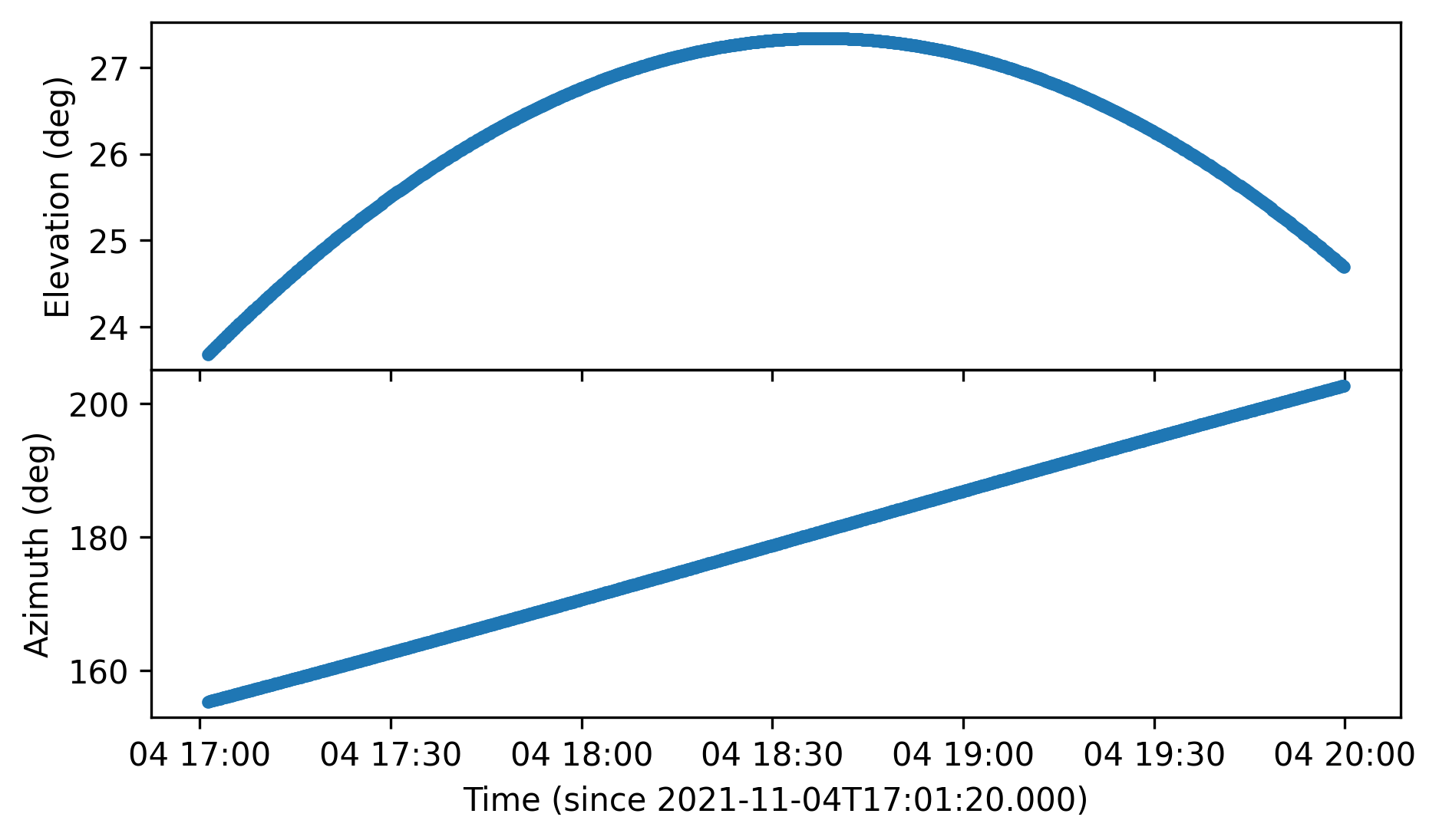Instrument Pointing
Instrument Pointing objects are defined to represent the instrument pointing with respect to time.
They can either be instantiated manually (see Predefined pointings) or from NenuFAR observation files (see Observation files).
In both cases, they are designed to be fed to the various methods while performing NenuFAR Beam Simulation.
Below, several packages are imported in preparation for the following examples.
>>> from nenupy.astro.pointing import Pointing
>>> from nenupy.astro.target import FixedTarget, SolarSystemTarget
>>> from astropy.time import Time, TimeDelta
>>> import astropy.units as u
>>> import numpy as np
See also
NenuFAR pointing for a detailed explanation on the different steps related to instrumental pointing.
Predefined pointings
Pointing instances can be fully customized according to the user preference.
However, the most reccurent pointing configurations are easily accessed via classmethods defined in the following.
Source tracking pointing
A Pointing instance aimed at following (or tracking) a particular celestial target can be initialized using target_tracking().
This classmethod takes as input the target, of type Target (see Astronomical Targets), to track.
The time argument describes the start time of each pointing step, while duration defines the time span of the pointing to this particular direction.
>>> cas_a = FixedTarget.from_name("Cas A")
>>> pointing = Pointing.target_tracking(
>>> target=cas_a,
>>> time=Time("2021-01-01 00:00:00") + np.arange(10)*TimeDelta(1800, format="sec"),
>>> duration=TimeDelta(1800, format="sec")
>>> )
In this example, pointing targets the source Cas A, and contains 10 successive pointing towards Cas A apparent position.
Note
The duration argument can be further described to set custom values for each individual pointing.
In order to visualize the results, the plot() displays the azimuth and elevation values computed from the requested parameters.
The keyword display_duration adds grey windows corresponding to the duration of each individual pointing (blue dots).
>>> cas_a = FixedTarget.from_name("Cas A")
>>> pointing = Pointing.target_tracking(
>>> target=cas_a,
>>> time=Time("2021-01-01 00:00:00") + np.arange(10)*TimeDelta(1800, format="sec"),
>>> duration=TimeDelta(np.ones(10)*1200, format="sec")
>>> )
>>> pointing.plot(display_duration=True)

Cas A tracking (in horizontal coordinates), spread across 10 time steps. The duration is highlighted as grey windows.
Source transit pointing
The second heavily used pointing type is source transit.
Using the classmethod target_transit(), it is possible to set up such pointing configuration.
In addition to target (Target, see Astronomical Targets), the user is expected to provide t_min.
The next source crossing at the requested azimuth is looked for, starting from t_min.
The pointing is then centered at the transit date, for a total duration.
>>> cyg_a = FixedTarget.from_name("Cyg A")
>>> pointing = Pointing.target_transit(
>>> target=cyg_a,
>>> t_min=Time("2021-01-01 00:00:00"),
>>> duration=TimeDelta(7200, format="sec"),
>>> azimuth=180*u.deg
>>> )
Note
It is also possible to ask for a different azimuth value, giving access to transits outside the meridian plane.
>>> cyg_a = FixedTarget.from_name("Cyg A")
>>> pointing = Pointing.target_transit(
>>> target=cyg_a,
>>> t_min=Time("2021-01-01 00:00:00"),
>>> duration=TimeDelta(7200, format="sec"),
>>> azimuth=100*u.deg
>>> )
Zenith pointing
Finally, it is also possible to define pointings fixed at the local zenith, using the classmethod zenith_tracking().
The behavior is similar than target_tracking(), except that there is no need to provide a specific target.
>>> pointing = Pointing.zenith_tracking(
>>> time=Time("2021-01-01 00:00:00") + np.arange(10)*TimeDelta(1800, format="sec"),
>>> duration=TimeDelta(7200, format="sec")
>>> )
Observation files
Each NenuFAR observation is delivered with two files describing both analog and numerical pointings.
These files can be used to instantiate a Pointing object, thanks to the classmethod from_file.
Using them as inputs is particularly useful while aiming at simulating the corresponding observation.
altazA file
An .altazA file describes the analog pointing of the Mini-Arrays, i.e., all pointing orders for each analog beam.
The columns can be read, from left to right, as ‘start time of the pointing’, ‘analog beam index’, ‘desired azimuth’, ‘desired elevation’, ‘corrected azimuth (after calibration)’, ‘corrected elevation (after calibration)’, ‘frequency at which the beamsquint effect is computed’, ‘elevation to point (taking into account the beamsquint effect)’.
;========================================================================================
; az cor, el cor : method 'mix'
;YYYY-MM-DD HH:NN:SS ANA az el az cor el cor Frq el a pointer
2021-11-04T17:01:10Z 0000 155.3537 24.3131 156.0355 23.8797 40MHz 7.8797
2021-11-04T17:07:10Z 0000 156.8850 24.7254 157.5571 24.2973 40MHz 8.2973
2021-11-04T17:13:10Z 0000 158.4292 25.1127 159.0913 24.6900 40MHz 8.6900
2021-11-04T17:19:10Z 0000 159.9858 25.4743 160.6375 25.0571 40MHz 9.0571
2021-11-04T17:25:10Z 0000 161.5539 25.8098 162.1950 25.3982 40MHz 9.3982
2021-11-04T17:31:10Z 0000 163.1331 26.1188 163.7633 25.7129 40MHz 9.7129
...
This file can directly be used to instantiate a Pointing.
The plot() method can be used to quickly visualize the pointings orders:
>>> altaz_a = ".../20211104_170000_20211104_200000_JUPITER_TRACKING.altazA"
>>> pointing = Pointing.from_file(file_name=altaz_a, beam_index=0)
>>> pointing.plot()

Analog pointing (horizontal coordinates) vs. time for a Jupiter observation.
Note
Another file is present in each NenuFAR observation repository: the so-called ‘tracking file’. This one lists the analog pointing orders used to control the delay lines. It looks like:
2021-11-04T17:01:10Z A 000 036 003 1 59 2 31
2021-11-04T17:01:10Z A 001 009 025 1 60 2 31
2021-11-04T17:01:10Z A 003 108 111 1 62 2 31
2021-11-04T17:01:10Z A 004 018 015 1 57 2 31
...
It is possible to reproduce these numbers, for checking purposes, using the MiniArray class.
For instance, the first line corresponds to the first time step, and the first Mini-Array (index 000).
We can read that the Xdelay and the Ydelay values are respectively 036 and 003.
From the .altazA file, above, we also read that the pointing order for the first time step, once the corrections are applied, is \((\phi=156.0355^{\circ}, \theta=7.8797^{\circ})\).
Using the hidden _skycoord_to_order() method, which takes as input a SkyCoord object for simplicity (that we set using the pointing coordinates), it is possible to find back these delay lines commands:
>>> from nenupy.instru import MiniArray
>>> from astropy.coordinates import SkyCoord
>>> import astropy.units as u
>>> ma = MiniArray(index=0)
>>> ma._skycoord_to_order(SkyCoord(156.0355, 7.8797, unit="deg"))
(36, 3)
altazB file
An .altazB file describes the numerical pointing of the NenuFAR array in beamforming operating mode.
Several numerical beams can co-exist (see NenuFAR pointing for more details), each with a given index BEAM.
Each numerical beam is linked to an analog beam (Mini-Arrays configuration), this is why the analog beam index ANA is associated to each line.
; ============================================================================================================
;YYYY-MM-DD HH:NN:SS ANA BEAM az (deg) el (deg) L M N
2021-11-04T17:01:10Z 0000 0000 155.3005 23.6678 0.382712881554200 -0.832095381992832 0.401432591550169
2021-11-04T17:01:20Z 0000 0000 155.3424 23.6800 0.382068139460654 -0.832297062149275 0.401628605986626
2021-11-04T17:01:30Z 0000 0000 155.3843 23.6923 0.381423336401039 -0.832498308203545 0.401824346309349
2021-11-04T17:01:40Z 0000 0000 155.4262 23.7045 0.380778195290465 -0.832699277533139 0.402019749747604
2021-11-04T17:01:50Z 0000 0000 155.4682 23.7167 0.380132857849189 -0.832899897616823 0.402214831816647
2021-11-04T17:02:00Z 0000 0000 155.5102 23.7289 0.379487324256145 -0.833100168358094 0.402409592592706
2021-11-04T17:02:10Z 0000 0000 155.5521 23.7411 0.378841591781727 -0.833300083263546 0.402604048128252
...
This file can directly be used to instantiate a Pointing.
The plot() method can be used to quickly visualize the pointings orders:
>>> altaz_b = ".../20211104_170000_20211104_200000_JUPITER_TRACKING.altazB"
>>> pointing = Pointing.from_file(file_name=altaz_b, beam_index=0)

Numerical pointing (horizontal coordinates) vs. time for a Jupiter observation.
Comparing the two last plots (made for the same observation), the beamsquint correction applied to the analog beam can clearly be seen. The pointed elevations, for the latter, are lower than the ones pointed by the numerical beam.